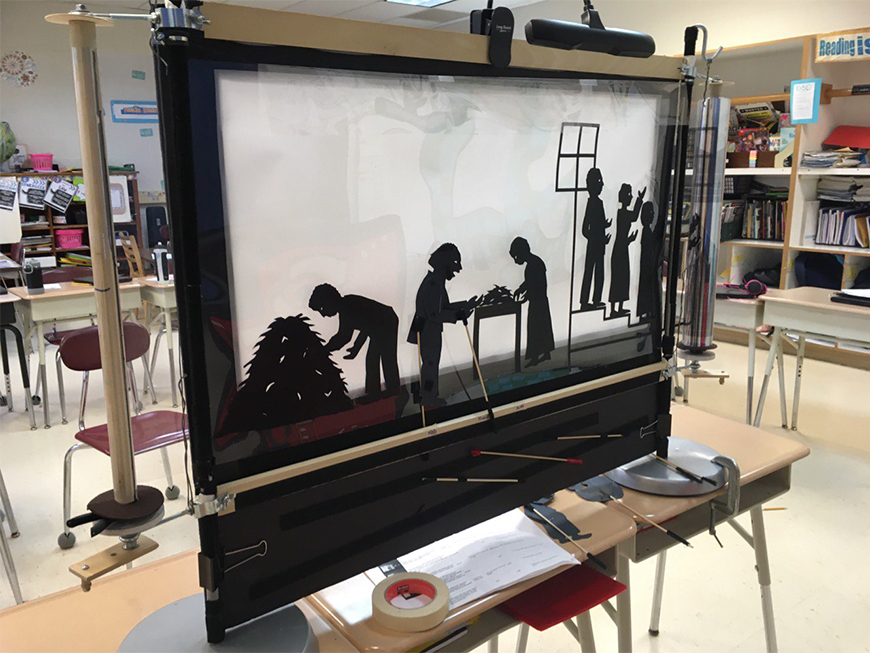In the past two years I have been fortunate to work with 5th grade teacher Davie-Lyn Jones. We explored shadow puppetry as an interactive way to teach about the “hard history” topic of slavery, using primary sources for the stories of Henry “Box” Brown and Harriet Tubman’s escape from slavery. Interrupted by the corona virus lockdown Davie-Lyn is offering her take on teaching the subject from home.
By Davie-Lyn Jones
New Jersey’s Amistad Commission charges school districts with writing curricula to teach the history of American slavery. For many years, these laws have informed my professional growth objective to engage students in meaningful and authentic conversations surrounding slavery and to craft lessons which create empathy for the experiences of the enslaved. Lessons devoted to teaching the hard history of slavery require both professional sensitivity and age-appropriate resources. The use of music, visual art, and shadow puppetry became a dynamic tool to increase student interest.
Literature and the Arts
Research has shown that arts educational experiences can produce significant positive impacts on academic and social development. I found that merging the Arts with classroom lessons, guided research, peer collaboration, and the performance task allowed students to engage with the resources creatively. I looked to the Language Arts standards to guide my selection of rich print and digital text resources. Rich literature paired with primary sources built student background knowledge. Ellen Levine’s Henry’s Freedom Box anchored the current unit. The text and illustrations make the life of Henry Box Brown accessible for children, providing insight into the limitations, hardships, and successes of one man’s life.
The story of Henry Box Brown
Shadow play of the story of Henry Box Brown as performed in the class, 2020
My partnership with puppetry artist Helene van Rossum started as a Black History Month workshop about the story of Henry Box Brown. The three workshop components included direct classroom instruction, a Past Times puppetry presentation, and an original student performance in March. In mid March, however, my states’ stay-at-home order prohibited the student performance component. Looking for ways to continue my students’ journey, I decided to exploit our workshop’s built in flexibility for virtual learning in this blog.
Virtual Learning at Home
Adjusting to learning at home is challenging. As I strive to develop engaging virtual lessons, I recognize that families are juggling home routines along with new educational responsibilities. The shadow puppetry workshop activities use art and creative play to deepen reading and writing skills. The educational websites I rely on to support these skills in my classroom are available at home. Scholastic’s Underground Railroad interactive and the audio recordings of former slaves build background knowledge. By reading Henry’s Freedom Box or listening to the audio version, students discover the hardships of slave life. Children can travel Henry’s escape route or read news articles recounting his journey to freedom. Through listening to the coded messages hidden in songs, students learn the importance of music during slavery. In freedom, Mr. Brown became a successful entertainer exposing audiences to the harsh realities of slavery. Students can sing along with Brown’s original lyrics set to a then popular melody or connect with recent recordings inspired by Brown’s story.
Shadow puppetry
Students embraced shadow puppetry theater and easily made connections to their own shadow hand puppetry experiences. After learning about Brown’s life and exploring the Past times site, students enthusiastically watched Helene van Rossum’s performance. In the discussion session, students learned that her creative art process includes visual arts, performance techniques, as well as research and writing. Our research continued using local fugitive slave ads, freedom accounts, and narratives. Students made individual shadow puppets.
Student performances
The stay-at-home order curbed the face-to-face interactions important for creating original student performances. Student groups still needed to reshape slave accounts into sketches, write and revise scripts, and rehearse their performances. To continue from home, the digital platform Google Classroom easily replaces face-to-face conversations with collaborative documents. With individual or shared documents, students are able to receive real-time teacher and peer feedback. In Flipgrid, students can make short videos to simulate the performance environment and practice puppetry skills. For the student performance in the classroom, the audience would have been our partner class, Ms. van Rossum, and the school principal. To simulate the live performance experience from home students could use Google Hangouts or simply post their polished performance in Flipgrid.
The workshop gives families an opportunity to explore individuals, events, or topics through the arts while building reading and writing skills. Below is a list of resources that may be used to teach the topic at home. To act out a performance of Henry Box Brown singing “Escape from Slavery in 1849, find instructions in this Past Times blog post!
Resource List
Henry Box Brown
- Henry Box Brown Encyclopedia Article
- Freedom by Express news articles
- Freedom account by William Still
American Slavery
- Scholastic Books Underground Railroad interactive
- Enslaved Audio stories
- Runaway slave advertisements (Somerset, NJ)
- Freedom on the Move: runaway slave ads by state
Music
- Coded Messages of the enslaved
- Sweet Chariot Hymn
- Henry Box Brown Modern song memorializing
Shadow Puppetry Performance Art
- Shadow puppetry
- Past Times Printable library

